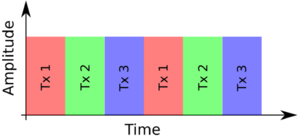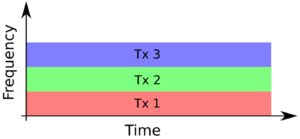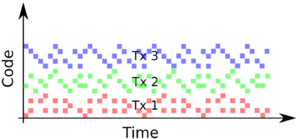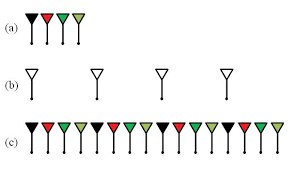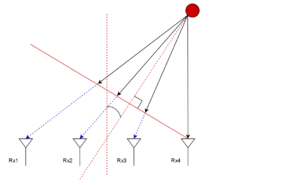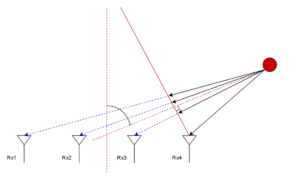Difference between revisions of "MIMO"
| (One intermediate revision by the same user not shown) | |||
| Line 3: | Line 3: | ||
!!!Page still under construction, revisit soon for complete version!!! | !!!Page still under construction, revisit soon for complete version!!! | ||
| − | |||
| − | MIMO | + | MIMO (Multiple Input Multiple Output) radars extend the traditional configuration of a single transmitter and receiver with the introduction of additional antennas. The motivation for introducing the multiple antennas is the ability to resolve the angular location of targets as well as making a system more robust to channel fading or other unfavorable operating conditions. |
| − | To achieve orthogonality, the transmitters must emit waveforms that are orthogonal in time, frequency or code, as illustrated below. | + | MIMO radar differs from Phased Array Radar, which similarly utilizes multiple receive and transmitting antennas, in that a MIMO signal transmits '''orthogonal''' waveforms from each individual transmit antennas, giving channel diversity across each of the individual transmitters to receiver path ("virtual channel"). |
| + | |||
| + | To achieve orthogonality, the transmitters must emit waveforms that are orthogonal in time, frequency, or code, as illustrated below. | ||
{| | {| | ||
| Line 21: | Line 22: | ||
|} | |} | ||
| − | The collection of resulting virtual channels between each transmitter and receiver form the virtual array whose dimensions are determined by spacing of antennas in both transmitter and receiver arrays. | + | The collection of resulting virtual channels between each transmitter and receiver form the virtual array whose dimensions are determined by the spacing of antennas in both transmitter and receiver arrays. |
{| | {| | ||
| Line 27: | Line 28: | ||
|} | |} | ||
| − | The result of constructing this virtual array gives rise to ability to resolve angular information from the received signals | + | The result of constructing this virtual array gives rise to the ability to resolve angular information from the received signals by estimating the phase differences between receive antennas. The images below illustrate how objects at particular angles from an antenna array give rise to phase differences experienced by the individual antennas. |
{| | {| | ||
Latest revision as of 13:40, 13 March 2021
!!!Page still under construction, revisit soon for complete version!!!
MIMO (Multiple Input Multiple Output) radars extend the traditional configuration of a single transmitter and receiver with the introduction of additional antennas. The motivation for introducing the multiple antennas is the ability to resolve the angular location of targets as well as making a system more robust to channel fading or other unfavorable operating conditions.
MIMO radar differs from Phased Array Radar, which similarly utilizes multiple receive and transmitting antennas, in that a MIMO signal transmits orthogonal waveforms from each individual transmit antennas, giving channel diversity across each of the individual transmitters to receiver path ("virtual channel").
To achieve orthogonality, the transmitters must emit waveforms that are orthogonal in time, frequency, or code, as illustrated below.
The collection of resulting virtual channels between each transmitter and receiver form the virtual array whose dimensions are determined by the spacing of antennas in both transmitter and receiver arrays.
The result of constructing this virtual array gives rise to the ability to resolve angular information from the received signals by estimating the phase differences between receive antennas. The images below illustrate how objects at particular angles from an antenna array give rise to phase differences experienced by the individual antennas.
